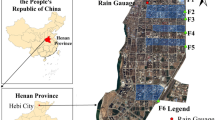Abstract
Hydrological responses and pollutant exports are always highly related to rainfall characteristics. Many studies have demonstrated that the influence of moving rainstorm on flows and mass transport process in hydrologic systems cannot be ignored. Best management practices (BMPs) are popularly applied for controlling water quantity and water quality in a watershed. Since the movements of rainstorm can influence watershed responses, BMP placement strategies should be suitably adjusted in different moving rainstorms. This study designed an intermediate rainfall pattern with varied movement behavior and tried to find the optimal BMP placement strategies, which cannot only satisfy environmental standards but also improve economic benefits, for the rainfall events. The result shows that the control efficiency of pollutant and runoff can highly improve when the BMPs are set near the outlet of a watershed. Since the economic efficiency is always regarded as an important factor, the BMP placement strategy is significant for watershed conservation and management.
Similar content being viewed by others
References
Bedient, P. B., & Huber, W. C. (2002). Hydrology and floodplain analysis. Upper Saddle River, NJ, USA: Prentice-Hall.
Chang, C. L. (2007). Influence of the pattern of moving rainstorms on watershed responses in a conceptual catchment. Environmental Engineering Science, 24(10), 1353–1360. doi:10.1089/ees.2006.0220.
Chang, C. L., Chiueh, P. T., & Lo, S. L. (2007). Effect of spatial variability of storm on the optimal placement of best management practices (BMPs). Environmental Monitoring and Assessment, 135(1–3), 383–389. doi:10.1007/s10661-007-9657-7.
Chang, C. L., Lo, S. L., & Yu, S. L. (2005a). Applying fuzzy theory and genetic algorithm to interpolate precipitation. Journal of Hydrology (Amsterdam), 314, 92–104. doi:10.1016/j.jhydrol.2005.03.034.
Chang, C. L., Lo, S. L., & Yu, S. L. (2005b). Interpolating precipitation and its relation to runoff and non-point source pollution. Journal of Environmental Science and Health-Part A, 40(10), 1963–1973.
Chaubey, I., Haan, C. T., Grunwald, S., & Salisbury, J. M. (1999). Uncertainty in the model parameters due to spatial variability of rainfall. Journal of Hydrology (Amsterdam), 220, 48–61. doi:10.1016/S0022-1694(99)00063-3.
Dijk, A. I. J. M. V., Bruijnzeel, L. A., & Rosewell, C. J. (2002). Rainfall intensity-kinetic energy relationships: A critical literature appraisal. Journal of Hydrology (Amsterdam), 261, 1–23. doi:10.1016/S0022-1694(02)00020-3.
Faures, J. M., Goodrich, D. C., Woolhiser, D. A., & Soroosh, S. (1995). Impact of small-scale spatial variability on runoff modeling. Journal of Hydrology (Amsterdam), 173, 309–326. doi:10.1016/0022-1694(95)02704-S.
Hromadka, T. V. (1996a). A rainfall-runoff probabilistic simulation program: 1. Synthetic data generation. Environmental Software, 11(4), 235–242. doi:10.1016/S0266-9838(96)00013-5.
Hromadka, T. V. (1996b). A rainfall-runoff probabilistic simulation program: 2. Synthetic data analysis. Environmental Software, 11(4), 243–249. doi:10.1016/S0266-9838(96)00014-7.
Jensen, M. (1984). Runoff pattern and peak flows from moving block rains based on linear time–area curve. Nordic Hydrology, 15, 155–168.
Lima, J. L. M. P. D., & Singh, V. P. (2002). The influence of the pattern of moving rainstorms on overland flow. Advances in Water Resources, 25, 817–828. doi:10.1016/S0309-1708(02)00067-2.
Lima, J. L. M. P. D., Singh, V. P., & Lima, M. I. P. D. (2003). The influence of storm movement on water erosion: storm direction and velocity effects. Catena, 52, 39–56. doi:10.1016/S0341-8162(02)00149-2.
Lu, S. Y., Cheng, J. D., & Brooks, K. N. (2001). Managing forests for watershed protection in Taiwan. Forest Ecology and Management, 143, 77–85. doi:10.1016/S0378-1127(00)00507-7.
Mostaghimi, S., Park, S. W., Cooke, R. A., & Wang, S. Y. (1997). Assessment of management alternatives on a small agricultural watershed. Water Research, 31(8), 1867–1878. doi:10.1016/S0043-1354(97)00018-3.
Pan, C. H. (1997). The optimal strategies of best management practices in a watershed. Taipei: Department of Civil Engineering, National Taiwan University, R.O.C. (in Chinese)
Sample, D. J., Heaney, J. P., Wright, L. T., Fan, C. Y., Lai, F. H., & Field, R. (2003). Costs of best management practices and associated land for urban stormwater control. Journal of Water Resources Planning and management, 129(1), 59–68.
Singh, V. P. (1998). Effect of the direction of storm movement on planar flow. Hydrological Processes, 12, 147–170. doi:10.1002/(SICI)1099-1085(199801)12:1<147::AID-HYP568>3.0.CO;2-K.
Tisdale, T. S., Kaighn, R. J., & Yu, S. L. (1996). The Virginia storm (VAST) model for stormwater management—User’s Guide version 6.0. Charlottesville, Virginia, USA: University of Virginia.
U.S. Army Corps of Engineers, Hydrologic Engineering Center (USACE-HEC) (1977). Storage, treatment, overflow, runoff model, STORM, USACE-HEC. Davis, California.
Wanielista, M. P., & Yousef, A. Y. (1993). Stormwater management. New York: Wiley.
Watts, L. G., & Calver, A. (1991). Effects of spatially-distributed rainfall on runoff for a conceptual catchment. Nordic Hydrology, 22, 1–14.
Yu, S. L., Stanford, R. L., & Zhai, Y. Y. (2003a). Virginia stormwater model for windows—User’s Manual version 1.0. Charlottesville, Virginia, USA: University of Virginia.
Yu, S. L., Zhen, X. Y., & Zhai, Y. Y. (2003b). Development of a BMP placement strategy for VDOT. Charlottesville, VA, USA: Department of Civil Engineering, University of Virginia.
Author information
Authors and Affiliations
Corresponding author
Rights and permissions
About this article
Cite this article
Chang, CL., Liou, TY. The placement strategies of structural best management practices for different moving rainstorms. Environ Monit Assess 166, 495–502 (2010). https://doi.org/10.1007/s10661-009-1018-2
Received:
Accepted:
Published:
Issue Date:
DOI: https://doi.org/10.1007/s10661-009-1018-2




